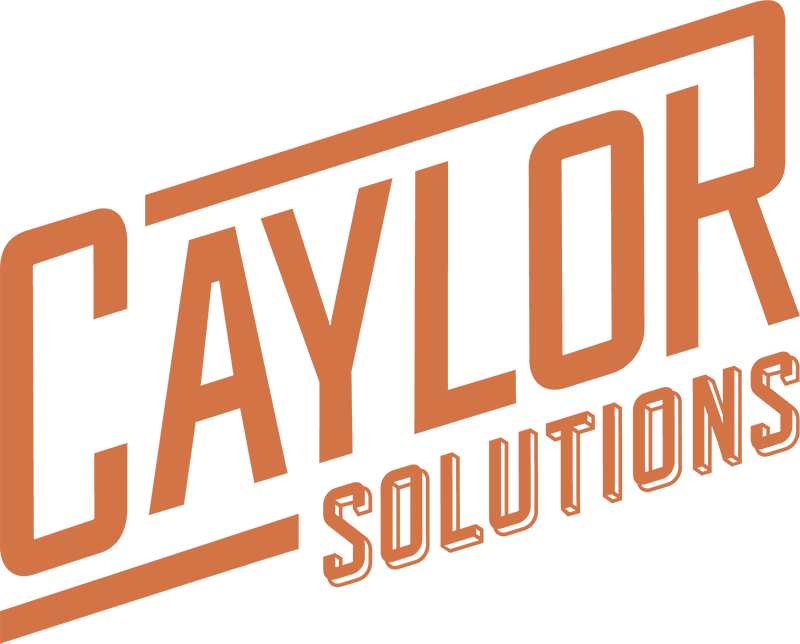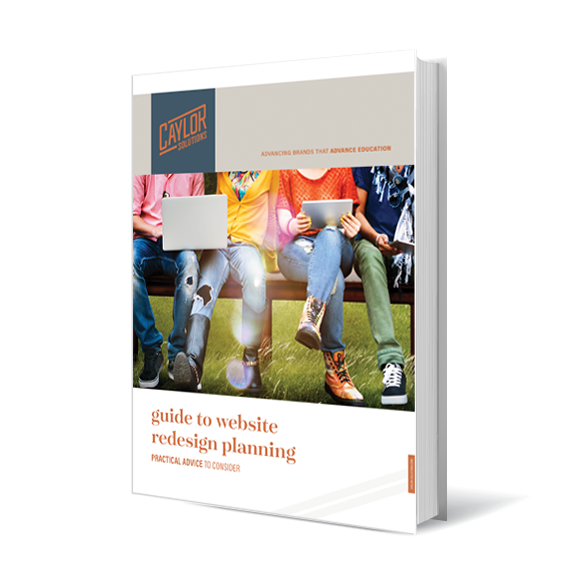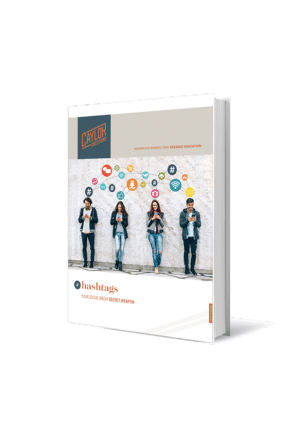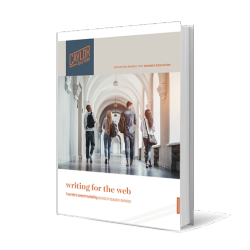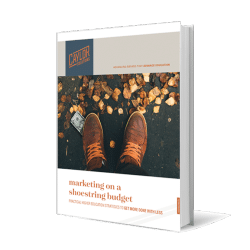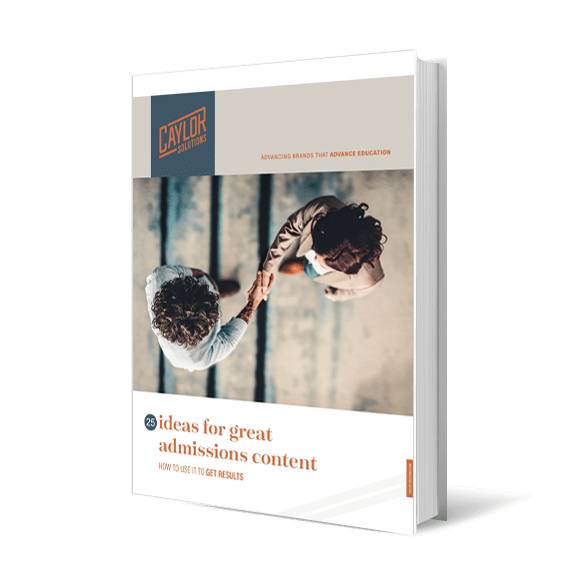Online learning platforms are a growing phenomenon. What began relatively recently with just a few players in the field is now a burgeoning business, and is often a key element of a school’s drawing power.
Sarah McMaster is the Executive Director of Marketing & Enrollment Management at Champlain College Online, one of the earliest schools to provide online learning opportunities. We invited her to The Higher Ed Marketer Podcast, to share with us her observations of the past, present and future evolution of online learning.
It’s All About Access
Sarah is on a mission. Providing online education possibilities is not just a job for her. She believes that everyone who wants a higher education should be able to obtain one. For her, online learning is all about that increased “accessibility”:
Accessibility can mean one thing in terms of compliance with the American with Disabilities Act, but what I’m talking about…is accessibility in terms of access to education. I spent the first decade or so of my career…working in our public colleges. The role of public education [is] to be accessible to everybody; it’s for the public good. That was very much my mindset for many years… But things evolve: I evolve, the [marketing industry] evolves, higher education evolves. So a few years ago I left the public system and went to work at a private institution…because my thinking about access had [grown].
I stand by the role of public education – it’s of great integral value to our society – but I had to expand my thinking about access: [There] is not a one size fits all solution for everybody.
So now [I am] working in an online education model. It is something that I think is growing and changing right in front of our eyes. I’m very excited to be in that space and to…evolve as a person, evolve as a professional, and see that there are other ways…that education can be accessible to whoever needs it.
Cause and Effect
I asked Sarah to expand a bit more on the changes that she has seen in the accessibility of education, especially with the rise of online learning. How did we get to where we are today?
I think there’s been two real big game changers… One was this “proof of concept,” if you will, with the early adopters… [Online learning] is viable from a business standpoint, and it suits the needs of education. The second game changer – something that I’m sure comes up in lots of conversations – is COVID 19… We [had] no other way to stay open. Those two things really caused what we’re seeing now, which is this explosion of options.
If we were having this conversation five, six years ago, we could [count] on all of our hands the players in the field. Now it would take us quite a long time to go through that list… [I]nstitutions…are coming into the online space, either because they’re seeing the need from the consumer / student standpoint, or from a revenue standpoint.
There’s different levers, or different motivators, in that. But we’re seeing that explosion… It’s [become] an incredibly competitive and crowded space.
The spread of online learning has coincided with a changing demographic of students who seek it. This means, of course, that marketing strategies also need to be adjusted:
Some of the things that I think about, [and] that I hope my colleagues and competitors are thinking about as well, is this presupposition that “modality” and “age” go together… [M]arketing to the “adult student” is no longer the dominant paradigm. I think we have to…put that on the table…
Is that really what we’re doing? Is that really what we want our message to be from a brand and offering standpoint?
[M]arketing has changed just like higher ed has changed. We had the golden age of marketing where we got to tell people, “Here’s a product, and here’s its features, and you want this product,” and…that worked. That doesn’t work anymore.
The next phase [was] the internet. Digital marketing came on the scene, and then it was: You serve an ad; you get a click through; that’s a win. That’s a success – you get them to your website… And, again, that has now gone by the wayside.
Now we’re in this different…messy-middle kind of place, where you learn that [for example] Champlain College Online exists, and … somewhere in the process you apply and you become a student, and everything between those two points is a mess. It’s a line that goes up and down and left and right… These models are not going to work for us anymore. We can no longer say, “They’re going to see our ad…10 times…and then we’re going to get them in.” It’s really not the case anymore.
We need to think about our [prospective students] in a different way, not only in terms of modality… [And] it’s not about out-spending; it’s about figuring out how to use the new tools that we have…to really stand out from [the] noise.
The Biggest Competition
I work with a lot of smaller schools who are worried about their ability to compete in the marketplace. I often tell them that their biggest competition is not the larger schools with huge marketing budgets. Their biggest competitor is just life – the life of the student. I shared that with Sarah, and she ran with it:
I do think that’s accurate… We are competing with students in terms of the other obligations that they have in their lives… I think that’s the case for any student, regardless of their age. But, I think rather than saying we’re competing with life, we should flip that [on its head] and say, “We have to fit into their life – how do we actually operationalize that?”
Is it [our] transfer credit policy? Is it [our] prior learning assessment? Does a prospect understand what that means? Is it credit for other kinds of professional experiences…can we recognize those things that are…happening in their life?
More than that, what are our processes internally that support a student who [is not]: “I start. I go all the way through every single term. I finish.” That is…not the behavior anymore. How are we accommodating students and meeting them where they are in terms of our readmit process? Our deferment process? Our articulations with community colleges?
We have to think about what we’re doing and meet students where they are, as opposed to saying, “[They] have to fit into us.” We need to fit into them.
Boiling it Down
One of the challenges that higher ed marketers face is to take all of the information that school administrators give to them and then translate it so that prospective students can understand it.
Sarah gave us two insights into this process from her own experience:
[First], it’s hard work, knowing how to say something really complicated…in a way that resonates for somebody who’s got 18 other things going on… For me, [the key is using] plain language. We have so much jargon [that] we can’t expect students and prospects to know… Expecting them to know what these terms are is already setting the bar too high, and setting them up to put a barrier in front of themselves.
If I can give one tip to every marketer out there listening: Go back to your team, go back to your website, go back to your view book, whatever it is that you have, and read it from a plain language standpoint. Circle every word that you have in there that you have to explain… [S]ee where you land.
[Second], it is hard to come up with [compelling] messages. Everybody can say “small class size,” or “friendly campus,” or “transfer friendly,” or whatever. That’s noise. Everybody is saying it. So, go dip into resources that you already have. [Talk to] your current students…to students that you lost…to alumni…to everybody, and [ask] them, “If we were a person, what would our personality be? If we could say one thing that nobody else could say, what is it?”…
From those conversations, you…won’t get the fully flushed out answer, [but] you will get the raw ingredients that you need to figure out how you can say all the things that you’re doing for your students in easy to understand [and digestible] bits that you can then work into your marketing.
AI Coming of Age
AI is here. We cannot (and should not) avoid it. How to regulate AI, and how to use AI, are top questions in many people’s minds.
Sarah sees both the hazards that AI creates, but also its possibilities – as long as we use it wisely:
I have this feeling that we’re not keeping up with the technologies that we’re creating. That’s of concern to me. But I also see it as…a great opportunity. [AI is] the hot thing right now. Everybody is talking about it, because we should be talking about it, [especially] in higher ed and in marketing.
I think the…main conversations going on right now are around academic integrity… [But] I think there’s…two more conversations that need to be happening. One is: How can we be thinking about tomorrow’s courses and programs so that we can teach our students to be ready for these new technologies in their careers?
The other [question] is at the societal level. We have the technological ability to make these things. We can make artificial intelligence. We can make large language models. We can make algorithms for social media platforms. But…just because we can do something, should we be doing something? Or, should we be doing it in a better way, in a way that causes less harm to teenagers and their mental health, that causes less internet addiction, and things of this nature?
Sarah is right. Those are important questions that we, as a society, need to answer. But, in the meantime, we still have to deal with the rise of AI in our workplaces:
I think change management is a really good lens through which to look at this and to kind of turn it around and say, “What are the pros? What are the cons?”…
One of the things that people are nervous about is losing their job… No, you’re not going to lose your job, but yes, your job is going to change. But I think it’s going to change in a good way. We’re going to be able to shift people to more meaningful work. At a tactical level in marketing, that could be less writing or editing…less content creation and more content crafting, or curating, or finalization.
We have new tools that can do some of that upfront work for us, but, as of today, those tools are not perfect. And so we, the humans, are still extremely necessary for those processes.
Pushing Boundaries
Major changes in available technology are nothing new. It wasn’t that long ago that we were all wondering how the internet could be profitably used in the classroom while avoiding its misuse by some to help them cheat. Those same ethical questions are being asked now about AI.
Sarah acknowledged the tension, and offered a practical solution:
Some students might cheat. Other students are never going to cheat. That doesn’t mean the students that might cheat are definitely going to use artificial intelligence. And it doesn’t mean the students that never cheat aren’t going to use artificial intelligence.
I also teach, and this was the first year that I had to put AI into my syllabus. I teach a class on digital ethics, and…we had to have a conversation about using AI for class assignments. But I think [that] if your students can cheat in your class with the assignments that you’re giving them now, that’s your problem, not their problem. You’re giving them the wrong assignments.
Something that we pride ourselves on [at Champlain College] is applied learning… Take, for example, project management… Project management is chock full of things you have to memorize. So if we’re giving students assignments that [require] rote memorization, we have failed. What we need to be doing is saying, “You’re going to take these time management skills in project management, you’re going to go to work tomorrow, and you’re going to apply [them]. And then you’re going to tell me about that experience.” We’re not [just] teaching people the rules of project management, but we’re teaching them how to apply them.
You can’t use ChatGPT for that!
Riding the Wave
To close out this episode, we asked Sarah for her direct advice to other higher ed marketers who are uncertain about the future with AI. Her answer was simple: Get used to it.
Everybody, go back to your office, or, if you’re in your office now, pull up your browser and start experimenting with an AI tool of your choice.. [T]his is a wave and…you’re either going to be surfing or you’re going to be under the water.
[S]tart thinking about prompt engineering. [T]he new coding language is now the English language, and so everybody has to be a prompt engineer… You get the best out of these tools based on the prompt that you put in. So think about your prompt as a recipe, and make sure you have certain ingredients. What is the task that you’re asking the tool to do? What is the role you are asking it to do that in?… Give it the context it needs… And then define the output.
Say, “I want this many words, written in AP style, written in an academic tone…” It’s only as good as the refinements that you give. Take that first answer, read it through, and then ask it for refinements. You’ll see that you get a much different result.
What you get out of [the] final refinement is still not your final product… You are now the human editor. We are not at the place where AI is done hallucinating and giving us false facts and all of this fun stuff that we’re experiencing in the toddler years.
We still need to be that human quality assurance that says, “I’m going to take this from where the tool can get me to where it needs to be.”
[AI is] only going to get you a certain fraction of the way there. The human is still absolutely a necessity in that process as well.
Discover more when you listen to the podcast!
Like all of our blog post reviews of The Higher Ed Marketer podcasts, there’s so much more to learn in the podcasts themselves.
Listen to our interview with Sarah McMaster to get even more insights into:
- The evolution of online education (6:49)
- Meeting students where they are (15:28)
- AI and change management (22:43)
Chasing Mission Fit
A Marketing Guide To Fill Your Institution With Students Who Will Succeed.
The essential marketing book every higher education institution needs! If you are a higher education marketing professional seeking a fail-safe plan to make your institution stand out, “Chasing Mission Fit” is your guide.
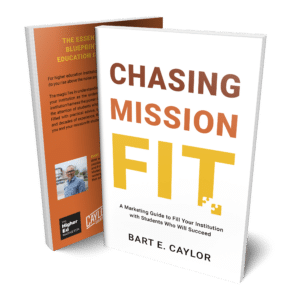
-
- Precisely target your ideal student
- Craft a compelling brand for your institution
- Implement a proven marketing strategy from 30 years of expertise
So you can empower your institution with audience-focused marketing strategies, and attract mission-fit students who will flourish in your unique academic environment.
Ready to transform your institution’s marketing approach?
Order now!
Featured image by Andrew via Adobe Stock
